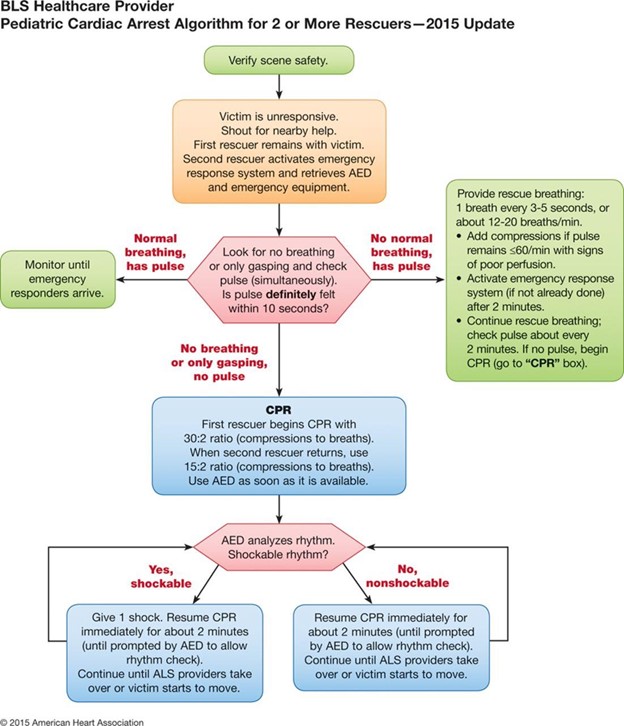Pediatric Assessment
- Scene Safety and Initial Assessment:
- Ensure Safety: Assess the safety of the scene for both rescuer and child.
- Assess Responsiveness: Check the child's responsiveness by tapping and shouting.
- Airway Management: Open the airway using appropriate maneuvers based on age (head-tilt-chin-lift for children and jaw-thrust for infants).
- Breathing Assessment:
- Check Breathing: Assess breathing by observing chest rise and fall, listening for breath sounds, and feeling for airflow.
- Ventilation: If breathing is absent or inadequate, provide rescue breaths using a bag-mask device with proper-sized masks for infants and children.
- Circulation Assessment:
- Check Pulse: Assess the pulse (carotid for infants, femoral for older children) for no more than 10 seconds.
- Chest Compressions: If pulse is absent, initiate chest compressions at a rate of 100-120 compressions per minute using appropriate techniques for infants and older children.

Nursing Test Bank
Quiz #1: RN Exams Pharmacology Exams
Quiz #2: RN Exams Medical-Surgical Exams
Quiz #3: RN Exams Fundamentals Exams
Quiz #4: RN Exams Maternal-Newborn Exams
Quiz #5: RN Exams Anatomy and Physiology Exams
Quiz #6: RN Exams Obstetrics and Pediatrics Exams
Quiz #7: RN Exams Fluid and Electrolytes Exams
Quiz #8: RN Exams Community Health Exams
Quiz #9: RN Exams Promoting Health across the lifespan Exams
Quiz #10: RN Exams Multidimensional care Exams
Naxlex Comprehensive Predictor Exams
Quiz #1: Naxlex RN Comprehensive online practice 2019 B with NGN
Quiz #2: Naxlex RN Comprehensive Predictor 2023
Quiz #3: Naxlex RN Comprehensive Predictor 2023 Exit Exam A
Quiz #4: Naxlex HESI Exit LPN Exam
Quiz #5: Naxlex PN Comprehensive Predictor PN 2020
Quiz #6: Naxlex VATI PN Comprehensive Predictor 2020
Quiz #8: Naxlex PN Comprehensive Predictor 2023 - Exam 1
Quiz #10: Naxlex HESI PN Exit exam
Quiz #11: Naxlex HESI PN EXIT Exam 2
Questions on Pediatric Assessment
Correct Answer is A
Explanation
<p>D. 2.5 inches (6.5 cm) is not the recommended compression depth for any age group in BLS.</p>
Correct Answer is B
Explanation
<p>D. Hyperextension of the head is not appropriate maneuvers for neonatal airway management.</p>
Correct Answer is C
Explanation
<p>D. Gasping respirations are not a reliable indicator of effective ventilation and may indicate cardiac arrest.</p>
Correct Answer is B
Explanation
<p>D. 5:1 is not a standard compression-to-ventilation ratio for any age group in CPR.</p>
Correct Answer is B
Explanation
<p>D. 2.5 inches (6.5 cm) is not the recommended compression depth for any age group in BLS.</p>
<p>D. Inserting an advanced airway device is part of the advanced steps in neonatal resuscitation after positive-pressure ventilation, chest compressions, and administering epinephrine.</p>
<p>D. Albuterol is a bronchodilator and is not indicated for bradycardia in neonatal resuscitation.</p>
<p>D. 120-140 compressions per minute is not a standard rate of chest compressions in neonatal resuscitation.</p>
<p>Hyperextension of the head is not appropriate maneuvers for newborn airway management.</p>
<p>D. Defibrillation, if indicated, is performed after the initial steps of neonatal resuscitation, including airway, breathing, and chest compressions. Drugs are administered after defibrillation if necessary.</p>
Search Here
Related Topics
- Stages of physical, cognitive, social and emotional development from infancy to adolescence - Pediatric Emergency Care
- Developmental milestones and screening tools - Pediatric Emergency Care
- Factors affecting growth and development - Pediatric Emergency Care
- Interventions to promote optimal development - Pediatric Emergency Care
- Conclusion - Pediatric Emergency Care
More on Nursing
Free Nursing Study Materials
Access to all study guides and practice questions for nursing for free.
- Free Nursing Study Trials
- Free Nursing Video tutorials
- Free Nursing Practice Tests
- Free Exam and Study Modes
- Free Nursing Revision Quizlets
